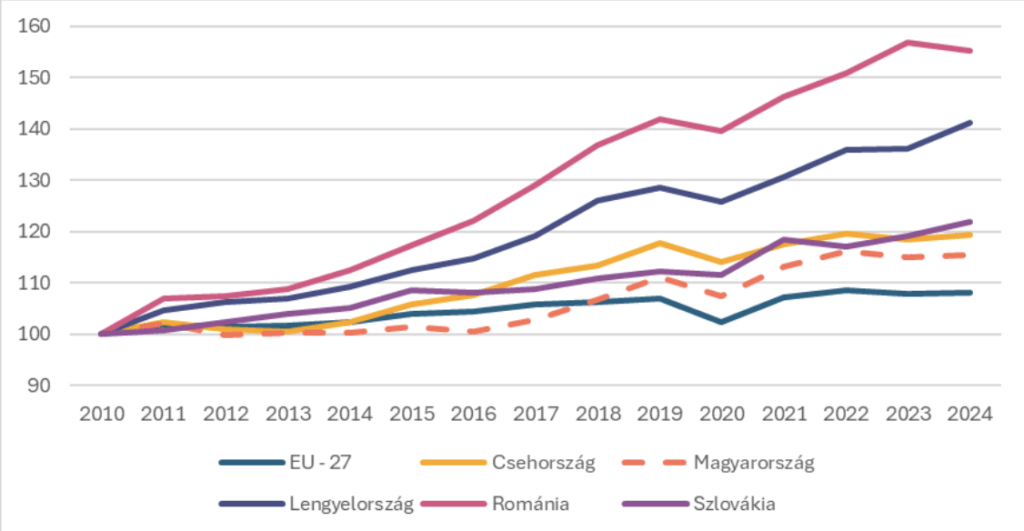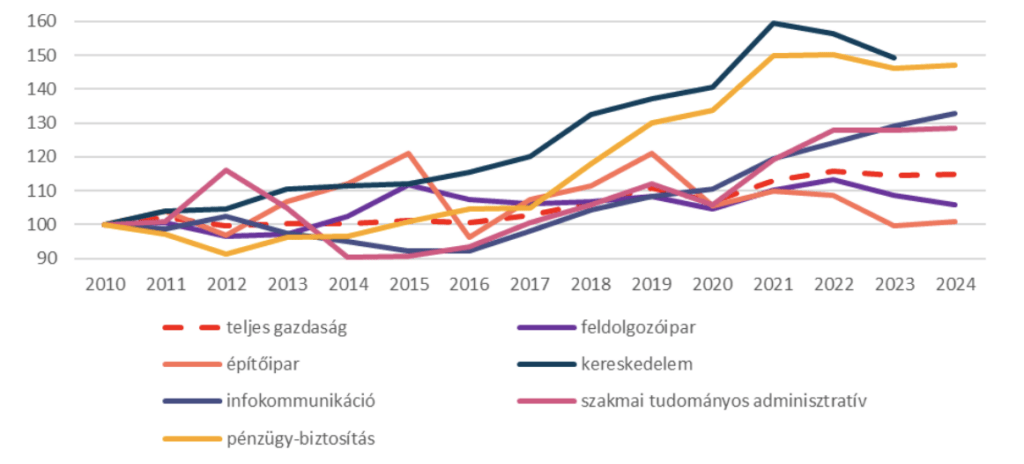GKI Analysis: We invest, but we don’t make progress
GKI has recently prepared a comprehensive series of analyses on the labor productivity of the sectors of the Hungarian national economy. The results show that the labor productivity of Hungarian companies lags behind that of their regional competitors, especially in the sectors that are the focus of economic policy. This raises the possibility that the current legal and economic incentives, as well as the support system, need to be reconsidered. From the perspective of long-term development of competitiveness, it would be important to achieve change in this area.
Labor productivity of the V4, Romania and the EU 27, 2010-2024 (2010=100)

Source: Eurostat
In an international comparison, we can see that the trends are basically similar The countries of the region (V4 countries and Romania) were included, but the rate of growth varied widely. All countries far exceeded the EU level: while the EU average approached +10% from below, the region was characterized by double it, but there were also five-fold levels.
Romania and Poland greatly outperformed the others, the former was able to increase labor productivity by 55%, the latter by 41%. In comparison, the Czech Republic and Slovakia also lagged behind with a performance of around 20%. In comparison, Hungary is the worst performing country among the examined countries (+15%). Hungary’s labor productivity improved between 2016 and 2022, before and after it practically stagnated or declined.
In the sectoral structure of Hungary, trade and finance-insurance came out on top with a productivity increase of around 50%, while the performance of infocommunications and the professional-scientific-administrative sector was also outstanding at 30-32%. The 15% indicator of the domestic national economy is “due” to the fact that the manufacturing industry’s value of barely 5% and the construction industry’s value of 0% dragged the average down. The share of dynamically improving labor productivity sectors in GDP is 30%, while the share of slowly developing sectors is 26%, while the lion’s share of budget support has flowed to the latter (especially to multinational assembly plants).
Productivity of the sectors of the national economy of Hungary, 2010-2024 (2010=100)

Source: Eurostat; (the above categories do not cover all economic activities)
The economic policy of recent years has placed significant emphasis on large-scale economic stimulus programs, especially on manufacturing investments, as well as on supporting large infrastructure and priority projects in the construction industry. In the short term, the expansion of resources may contribute to the development of certain sectors, but in the long term it will only have a positive impact and improve labor productivity if companies are encouraged to operate more efficiently, innovate and be cost-conscious.
In light of this, it would be more reasonable to consider allocating future subsidies to areas in which Hungary has a comparative advantage and which offer sustainable growth in the long term. This is in contrast to the current practice, which supports industries that require a lot of imported raw materials, energy and guest workers (battery and car manufacturing). In addition, it would be justified to further develop the economic policy toolbox: introducing more sophisticated, predictable and effective incentives that build on existing comparative and competitive advantages and take greater account of the interests of domestic small and medium-sized enterprises.
Related news
KSH: industrial producer prices in November 2025 were on average 2.7 percent lower than a year earlier and 0.3 percent lower than the previous month’s prices
🎧 Hallgasd a cikket: Lejátszás Szünet Folytatás Leállítás Nyelv: Auto…
Read more >Fidelity Kitekintés 2026: Ne becsüljük alá az inflációt!
🎧 Hallgasd a cikket: Lejátszás Szünet Folytatás Leállítás Nyelv: Auto…
Read more >Company Trend 2025 – domestic businesses under strong pressure, in a negative trend
🎧 Hallgasd a cikket: Lejátszás Szünet Folytatás Leállítás Nyelv: Auto…
Read more >Related news
The 6 most important payment trends in 2026:
🎧 Hallgasd a cikket: Lejátszás Szünet Folytatás Leállítás Nyelv: Auto…
Read more >Tourism continues to expand dynamically
🎧 Hallgasd a cikket: Lejátszás Szünet Folytatás Leállítás Nyelv: Auto…
Read more >FEOSZ creates a certificate for consumer-friendly web stores
🎧 Hallgasd a cikket: Lejátszás Szünet Folytatás Leállítás Nyelv: Auto…
Read more >







